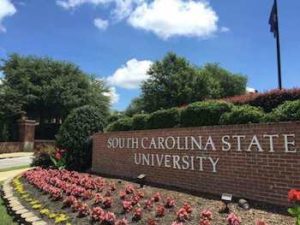
*1896 South Carolina State University (SCSU) became a Historically Black College or University (HBCU). It is located in Orangeburg, South Carolina. It is the only public HBCU land-grant institution in South Carolina.
SCSU is a member school of the Thurgood Marshall College Fund and is accredited by the Southern Association of Colleges and Schools (SACS). The university began as the South Carolina Agricultural and Mechanical Institute in 1872 in compliance with the 1862 Land Grant Act within the institution of Claflin College, now known as Claflin University. In 1896, the South Carolina General Assembly passed an act of separation. It established a separate institution, the Colored Normal Industrial Agricultural and Mechanical College of South Carolina, which was its official name until 1954.
20th-century academic programs received more attention as the student population increased, but other programs, such as the university's high school, were forced to close due to the Great Depression. The New Deal Programs were used to create, among other things, Wilkinson Hall, the university's first separate library building. The college's campus also purchased over 150 acres for agricultural learning. After World War II, many students flocked to the college, creating a classroom shortage problem. In 1947, the United States Army created an ROTC detachment in which all male students were required to enroll until mandatory enrollment ended in 1969.
The South Carolina General Assembly was renamed South Carolina State College in 1954. Because of the "separate but equal" laws in the state, the legislature gave the college large sums of money to build new academic facilities and dormitories, some of which still stand on the campus today, including the Student Union (1954) and Turner Hall (1956). This was done to give black students an "equal" education environment. Also, the legislature created a law program for the college, mainly to prevent black students from attending law school at the then-segregated University of South Carolina. It folded in 1966 after the University of South Carolina integrated.
During the height of the 20th-century American Civil Rights Movement, many students participated in marches and rallies to end segregation. The struggle came to a climax on the night of February 8, 1968, when three students were killed in the Orangeburg Massacre. From the late 1960s to the mid-1980s, under the leadership of M. Maceo Nance, the campus experienced unprecedented growth in the form of new academic buildings, such as Nance Hall (1974) and Belcher Hall (1986), new residence halls, such as Sojourner Truth Hall (1972), which, at 14 stories, is the tallest building in Orangeburg County, and a new library building (1968), not to mention enlargements and renovations of existing facilities. The school also opened the I.P. Stanback Museum & Planetarium, the only facility on a historically black university campus in the United States.
After Nance's retirement in 1986, Albert Smith assumed the office of the school's president and, among other achievements, created an honors college in 1988. During Smith's tenure, the school gained university status from the South Carolina General Assembly, becoming South Carolina State University in February 1992. In 1993, Barbara Hatton became the school's first female president. She created many improvements for the campus, such as the 1994 renovation of Oliver C. Dawson Bulldog Stadium, the construction of new suites and a larger press box, and the increasing its capacity to 22,000. Hatton also spearheaded the creation of a plaza that resides in front of the Student Union and passes by several dorms and buildings in the central portion of the campus.
Under S.C. State's next president, Leroy Davis, South Carolina State University celebrated its 100th anniversary in 1996. The school constructed a Fine Arts Center in 1999, giving the Art and Music departments a new home. George Cooper, formerly with the U.S. Department of Agriculture, assumed the presidency of S.C. State on July 16, 2008, and was the tenth president at SCSU University. The SC State Board of Trustees voted to terminate Cooper's contract on June 15, 2010. John E. Smalls, senior vice president of finance, was appointed to lead the university in the interim. President Cooper was reinstated two weeks later after a change in board membership. Andrew Hugine, Jr.'s predecessor was also dismissed and sued the university, eventually accepting $60,000 to drop his suit for defamation and breach of contract.